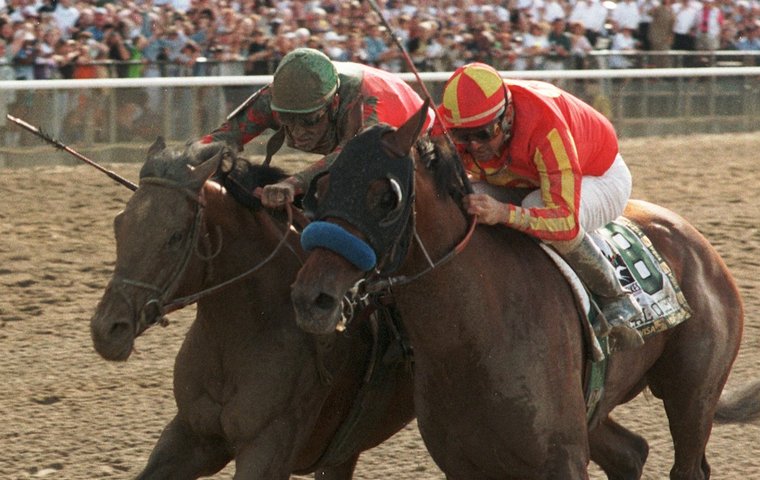
Jay Hovdey’s unmissable series with the story of the Bob Baffert-trained star who missed out on the Triple Crown by the narrowest of margins
It makes no sense that a two-time classic winner, Eclipse champion, and sire of a champion would need someone to come along barely a dozen years after his death to shake the memory tree.
All this guy did was finish 1-2-3 in 17 of 20 starts and win G1 stakes at two, three and four, while also being denied the right to be called a Triple Crown winner by the slimmest margin in history.
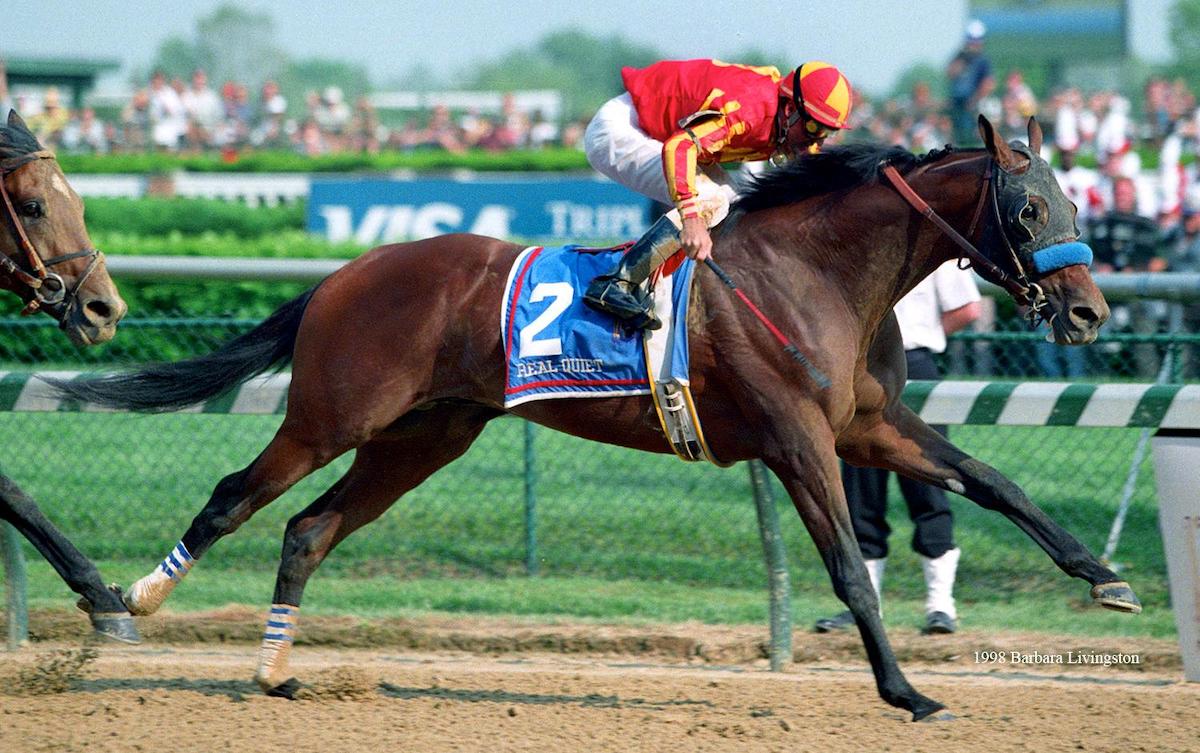 But here we are. Real Quiet, backed by the high-rolling pair of owner Mike Pegram and trainer by Bob Baffert, was the earnest middle child in a family of three straight Triple Crown attempts in the late 1990s, bracketed on one side by the charismatic Hall of Famer Silver Charm and on the other by Charismatic himself, who broke down trying to win racing’s greatest prize. In such company, the memory of almost any other horse might be hazy.
But here we are. Real Quiet, backed by the high-rolling pair of owner Mike Pegram and trainer by Bob Baffert, was the earnest middle child in a family of three straight Triple Crown attempts in the late 1990s, bracketed on one side by the charismatic Hall of Famer Silver Charm and on the other by Charismatic himself, who broke down trying to win racing’s greatest prize. In such company, the memory of almost any other horse might be hazy.
A fishy tale
Then again, Real Quiet’s nickname around the barn was ‘The Fish’, hardly an inspiring sobriquet in the spirit of Big Train, Big Red, or the Gray Ghost of Sagamore. It was Baffert’s first impression that summoned the image of a tropical sea creature.
“You know, real pretty if you look at him sideways,” Baffert said. “But kind of narrow when you see him head-on. It’s a good thing he was already named because that’s what we probably would have named him. But he was a beautiful horse, just a beautiful specimen.”
Real Quiet was the second Baffert-trained horse (after Silver Charm) to contribute to his tally of 17 American Classic winners and earned a robust $3.2m. But as a $17,000 yearling purchase, little was expected of the plain-wrapped, coppery bay, topped by the tiniest drip of white between his eyes that passed for flare. He meandered through his first dozen races with a lot more misses than hits, raising and dashing the hopes in equal measures.
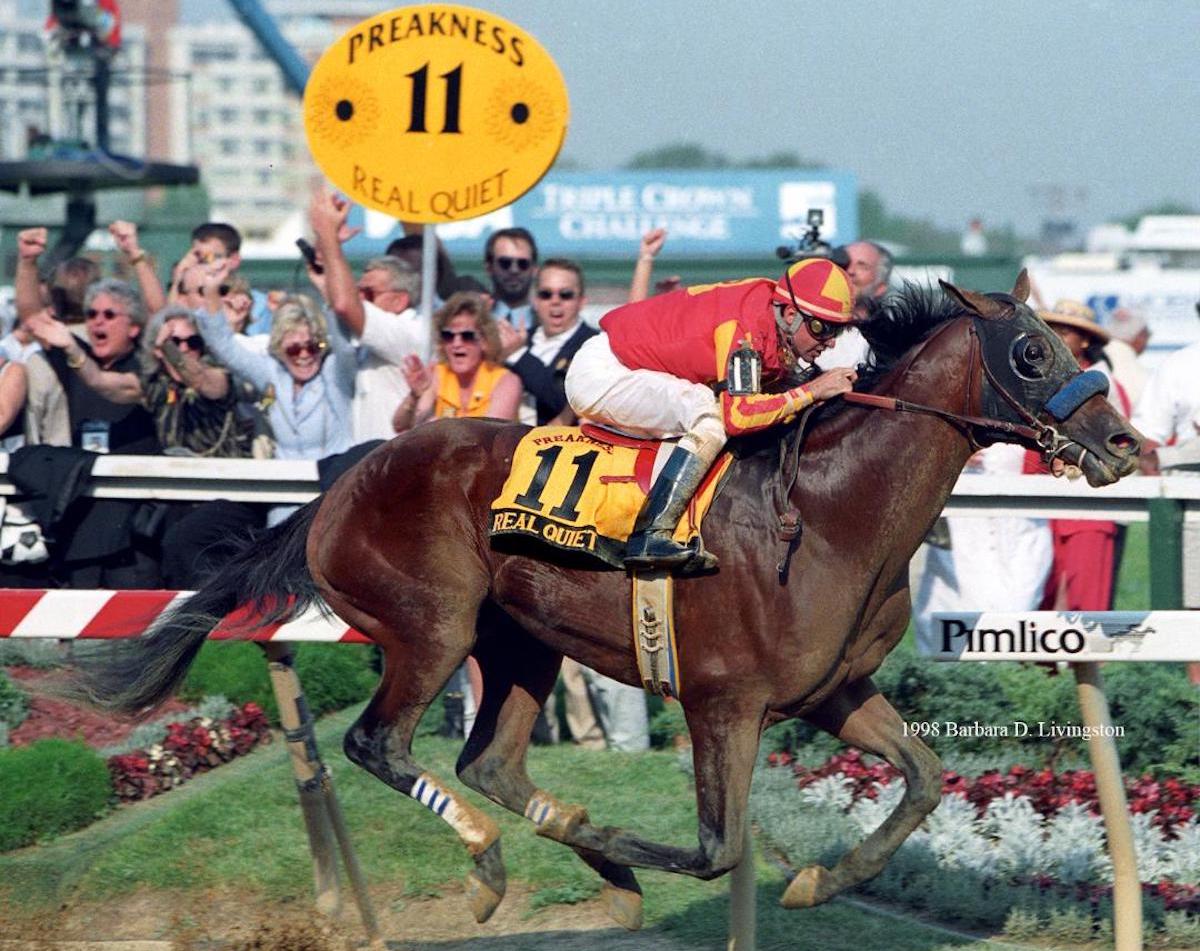 “When he started out, he always showed he could run, but he couldn’t put it together in the afternoon,” Baffert said. “He was a big, awkward colt. But as soon as we started running him long, it turned him around.”
“When he started out, he always showed he could run, but he couldn’t put it together in the afternoon,” Baffert said. “He was a big, awkward colt. But as soon as we started running him long, it turned him around.”
By the spring of his three-year-old season, the distracted boy had grown into a man of purpose, just in time for the 1998 Classics. Visitors to the Baffert barn looked at the vaguely familiar colt, now a headline horse, and wondered aloud: “Who is this, and what did you do with the real Real Quiet?”
“We’d been asking him to do things he really wasn’t meant to do,” said Pegram, an Indiana native who grew up with dreams of being part of the Kentucky Derby.
‘He was unbelievable’
“Starting off at five furlongs. Hauling him to New Mexico to run seven furlongs. Here’s a horse who lost only one race going more than a mile and one-eighth in his life, and that was by a nose in the Belmont. He was unbelievable.”
Clearly, Real Quiet needed a while to come to terms not only with his physical imperfections, but also a heritage that required patience and leaned heavily on racing over a distance of ground.
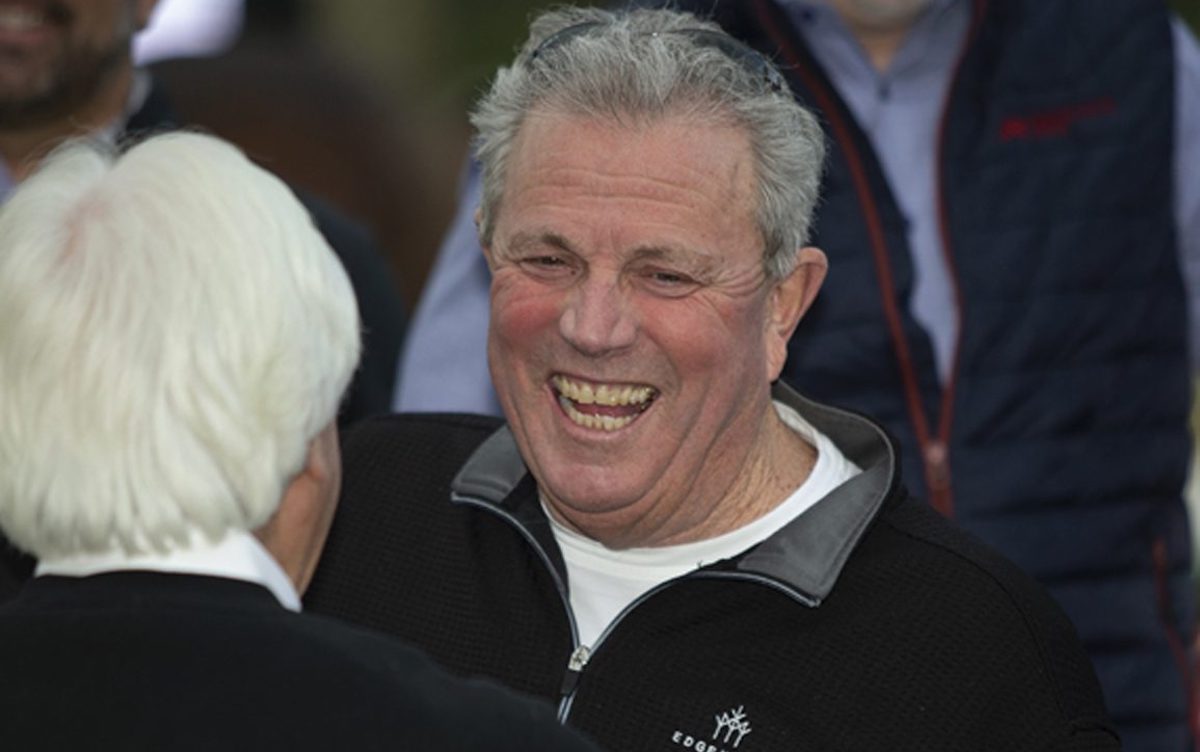 Quiet American, the sire of Real Quiet, was living proof of the everlasting impact of John Nerud, the Hall of Fame trainer who created a Thoroughbred dynasty with 320 central Florida acres and a large pile of money from William McKnight, CEO of Minnesota Mining and Manufacturing Co., better known as 3M.
Quiet American, the sire of Real Quiet, was living proof of the everlasting impact of John Nerud, the Hall of Fame trainer who created a Thoroughbred dynasty with 320 central Florida acres and a large pile of money from William McKnight, CEO of Minnesota Mining and Manufacturing Co., better known as 3M.
By the mid-1980s, the horses coming from the Nerud operation at Tartan Farms had included champions Dr. Fager, Ta Wee, and Dr. Patches, Preakness Stakes winner Codex, Breeders’ Cup winner Cozzene, and the major stakes winners Fappiano, Land Girl, Muttering, and Western Warrior, among others.
As a foal of 1986, by Fappiano out of a Dr. Fager mare, Quiet American seemed a sure thing to join that group. By then Tartan was owned by McKnight’s daughter, Virginia, and her husband, James Binger. However, in 1987 they decided to sell their bloodstock, including Quiet American and his fellow yearlings, at a Fasig-Tipton Kentucky dispersal that rivaled anything Sotheby’s could offer. Sheikh Mohammed bought the son of Fappiano for $300,000.
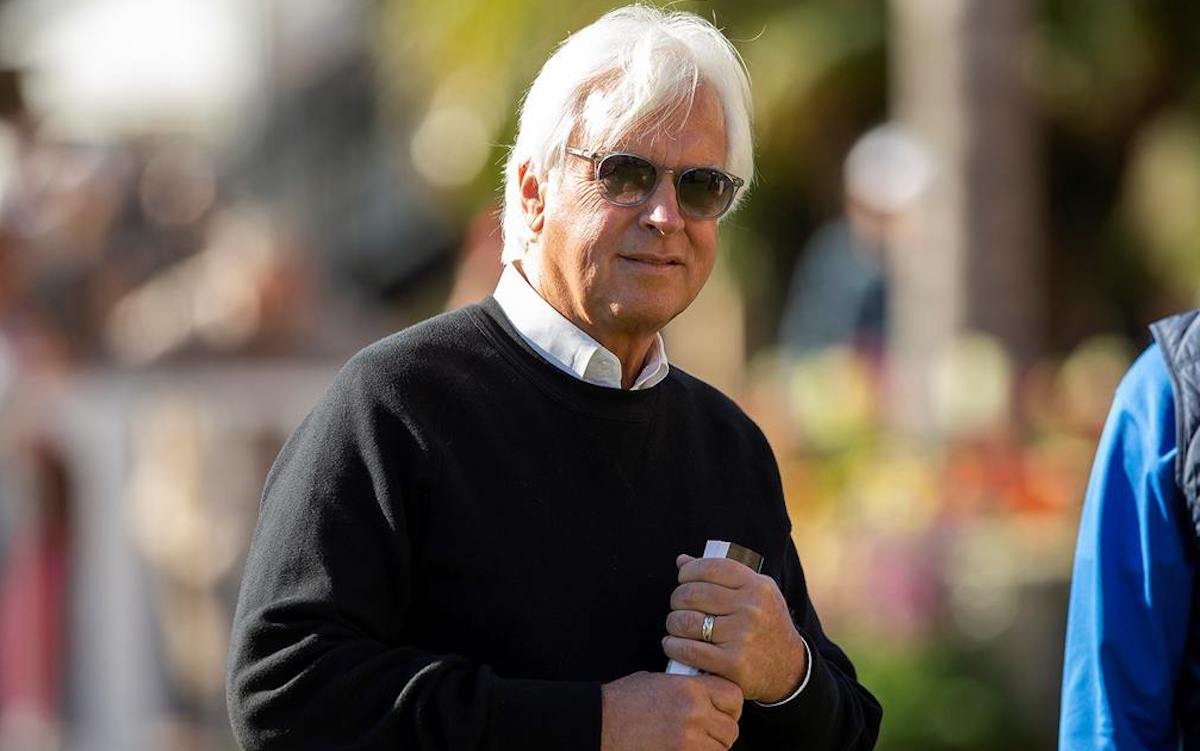 Quiet American was first trained in England by Michael Stoute and lost all three starts. It was eventually determined the colt had breathing issues, prompting his transfer to Gary Jones and the drier climes of California, where the helpful diuretic Lasix was legal.
Quiet American was first trained in England by Michael Stoute and lost all three starts. It was eventually determined the colt had breathing issues, prompting his transfer to Gary Jones and the drier climes of California, where the helpful diuretic Lasix was legal.
Jones treated Quiet American like the gem he was, allowing plenty of time between starts and lining the colt’s stall with protective sheeting in deference to his allergies.
Quiet American won two minor races and then finished a close second in the 10-furlong Strub Stakes at Santa Anita before coming back on four weeks rest to run poorly in the 1990 Santa Anita Handicap. He regained his form that summer to win the San Diego Handicap at Del Mar, then finished second in the Woodward Handicap at Belmont Park.
Passed over
Much to the chagrin of Jones and the shiekh, the in-form Quiet American was passed over by the Breeders’ Cup selection committee when the field for the 1990 Classic at Belmont Park was compiled. 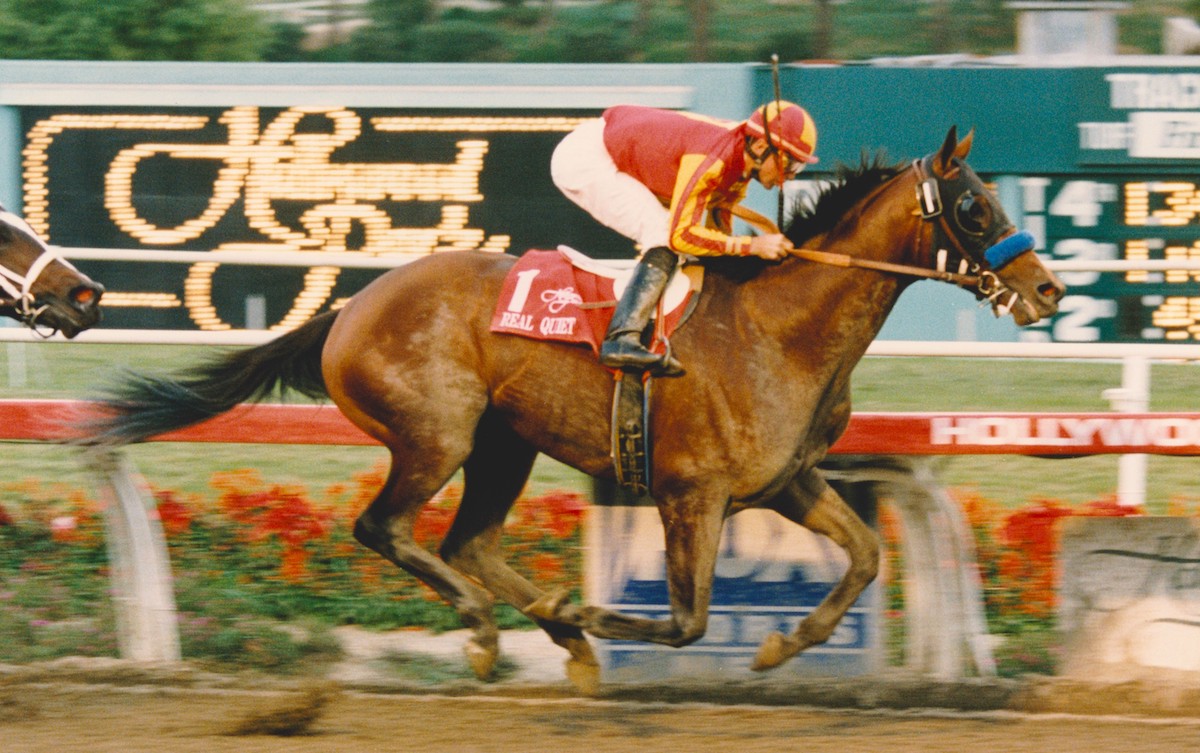
Undaunted, Jones kept the horse in New York and managed to withhold a legitimate ‘I told you so’ after Quiet American won the NYRA Mile, geared down, in a time that brushed close to Dr. Fager’s world record.
After a single start in 1991, Quiet American’s robust, 21-year stallion career commenced for Darley America in 1993. The following season, he was introduced to the Believe It mare Really Blue, who came equipped with a bulletproof pedigree of her own. Her dam, Meadow Blue, was an unraced full-sister to Majestic Prince, winner of the 1969 Kentucky Derby and Preakness, and a half-sister to Betty Lorraine, dam of 1974 Prix du Jockey Club winner Carocolaro.
Really Blue won three of 21 starts on the Mid-Atlantic-New England circuit, and as a young broodmare she was similarly undistinguished until Eduardo Gaviria, a breeder from Colombia, bought her for $37,000 while in foal to Spend A Buck.
Giving credit where credit was due, Gaviria took the advice of bloodstock consultant Jack Werk on the selection of Quiet American as Really Blue’s subsequent mate. The resulting foal arrived on March 7, 1995, at Gaviria’s Little Hill Farm in Ocala.
In the flesh, the yearling version of Real Quiet did not live up to the advantages bestowed by his pedigree, at least not in the commercial ring. Gaviria consigned him to the 1996 Keeneland September yearling sale and might have been lucky to get the $17,000 he did from Pegram, who made his fortune out west owning a collection of McDonald’s restaurant franchises.
Real Quiet was sent back to Florida for his early lessons with the McKathan brothers, J.B. and Kevin, who found Silver Charm for Baffert and Bob and Beverly Lewis. Once at the track, during early spring 1997, Real Quiet made two unsuccessful starts in Kentucky in June.
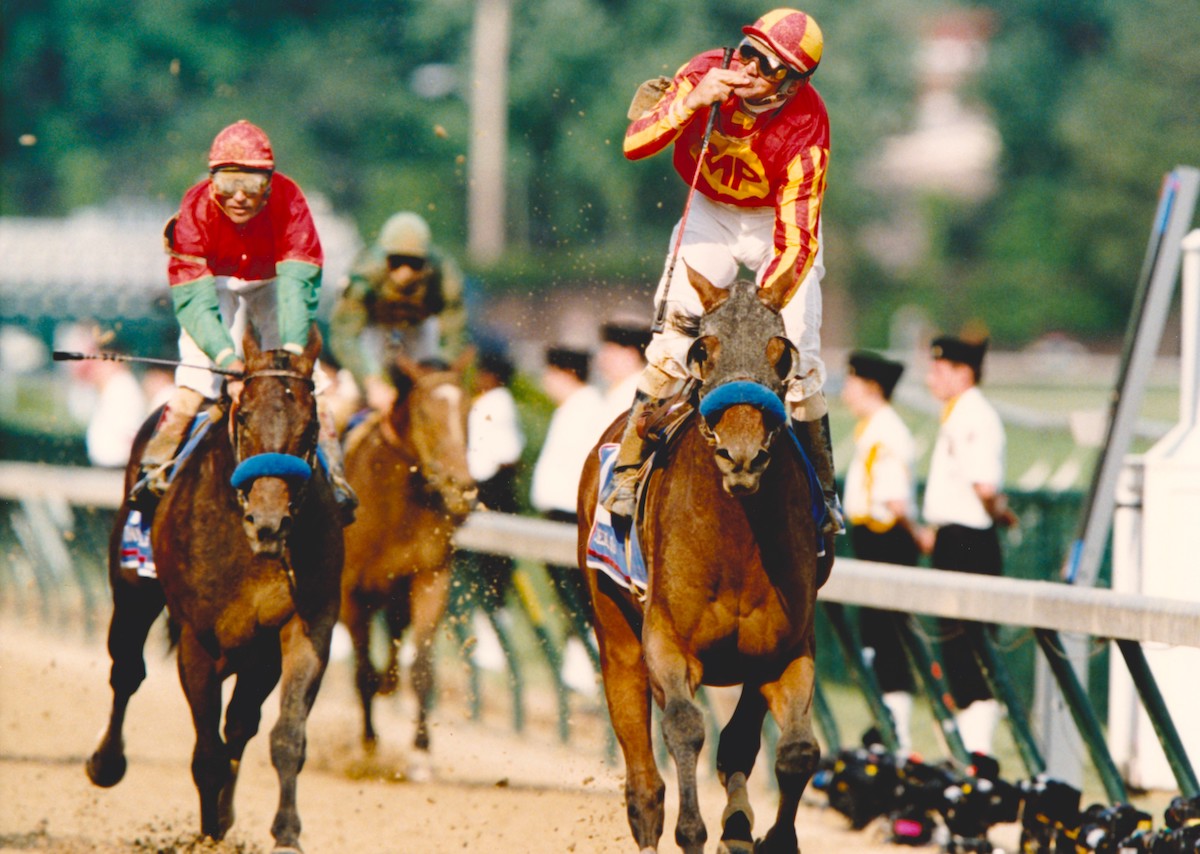 After another dreary outing at Hollywood Park, the Baffert-Pegram brain trust zeroed in on what looked like an easy spot for a huge payday, even for a non-winner like Real Quiet.
After another dreary outing at Hollywood Park, the Baffert-Pegram brain trust zeroed in on what looked like an easy spot for a huge payday, even for a non-winner like Real Quiet.
The road less traveled
So off he went to Santa Fe Downs in northern New Mexico, at an elevation of 7,199 feet, a small track in a beautiful natural setting purchased the year before by the Pojoaque Pueblo tribe. In an attempt to invigorate their new enterprise, the owners created the Indian Nations Futurity Cup, with thousands of dollars in eligibility fees larded onto $250,000 in seed money from management.
First, though, Real Quiet had to qualify in a trial, which he did by the skin of his teeth. In the grand finale, with a total purse of $571,647, Real Quiet finished third once again to grab a prize of $44,000. As for the Indian Nations Futurity Cup, there was never a second running. Santa Fe Downs went out of business as a racetrack the following year.
Real Quiet finally found a maiden race with his name on it at Santa Anita that fall, then was on the road again to finish a troubled third in the Kentucky Jockey Club Stakes at Churchill Downs.
Such a promising trajectory prompted his people to try the Hollywood Futurity, with its purse of $474,200, although Real Quiet was considered the lesser half of an entry with the Pegram-Baffert colt Johnbill, a son of Slew City Slew who had just finished fifth in the Breeders’ Cup Juvenile at Hollywood Park.
Horseplayers who took 3-2 on the entry spent the first half of the mile and one-sixteenth Futurity wondering when Johnbill would pick up the bit. Approaching the far turn, they gave up and shifted their attention to Real Quiet, who was getting a picture perfect inside trip under Kent Desormeaux. 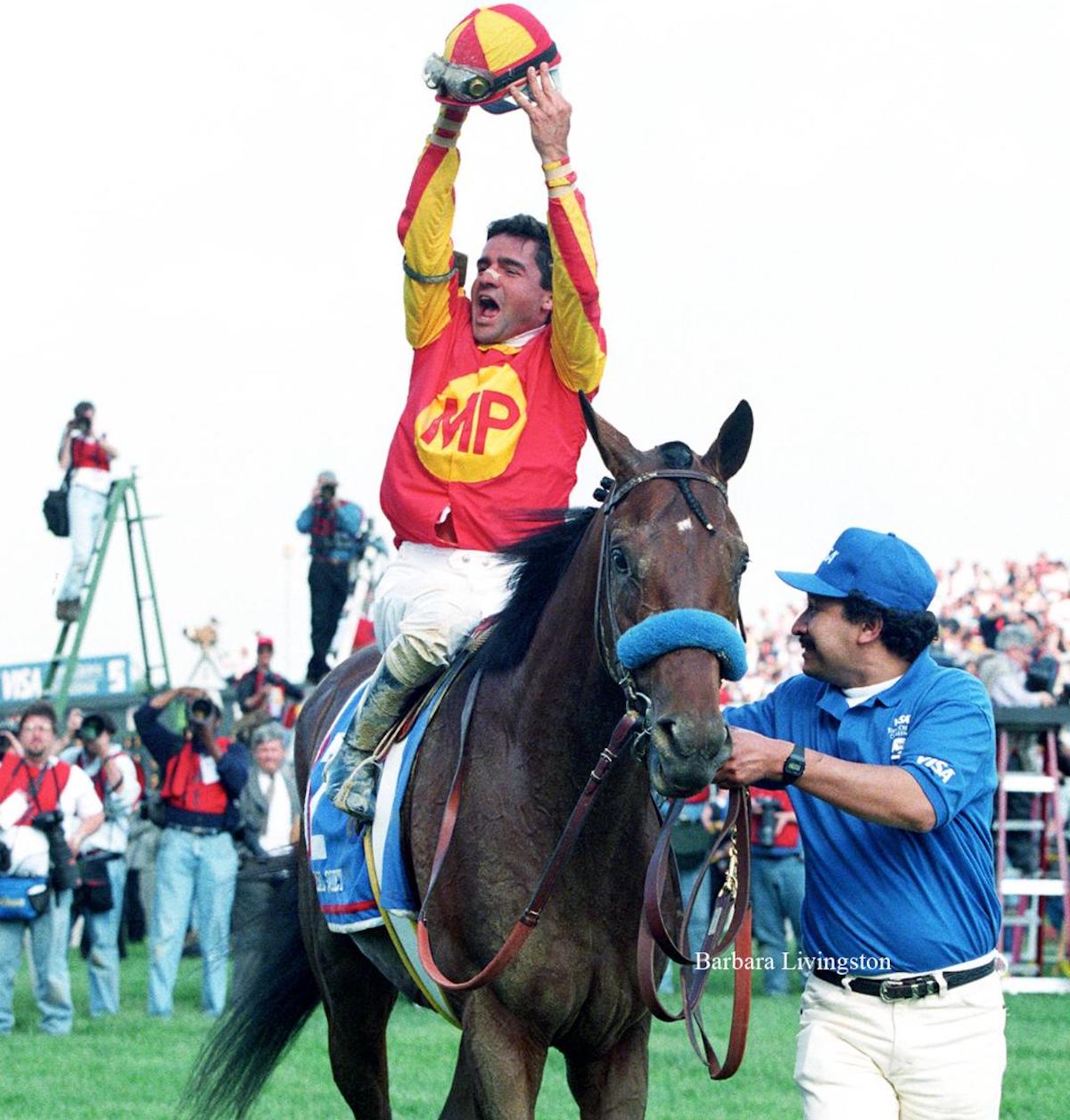
Turning for home, Desormeaux shifted to the outside of pacesetting Double Honor and struck for the front, while challenged on the right from the impressive maiden race winner Artax.
Real Quiet finished with newfound authority to keep Artax at arm’s length and win by a length in 1:41.34. “The Fish has turned into a shark!” proclaimed Baffert.
Real Quiet’s first start at three was a wasted effort over a muddy track he loathed in the Golden Gate Derby. Two months later, he was back on dry ground in the San Felipe Stakes at Santa Anita, running a bang-up second to Artax.
Then, in their Santa Anita Derby rubber match, Real Quiet easily handled Artax but could not catch his Baffert stablemate, Indian Charlie.
After finishing an agonizingly close second with Cavonnier in 1996 and winning the Derby in 1997 with Silver Charm, Bob Baffert arrived at Churchill Downs still the shiny new object captivating the racing press.
Indian Charlie, named for a satirical racing newsletter, and his stablemate known as The Fish provided the media a one-two aphrodisiac that lasted all week.
More than California curiosities
They proved to be more than California curiosities. Real Quiet and Desormeaux took charge of the 124th Derby rounding the final turn with a sweeping move on the outside to catch and pass Indian Charlie. Arkansas Derby winner Victory Gallop came with a frantic late run to make the margin three-quarters of a length at the wire.
“After he won the Derby, you could just see him blossom,” Pegram said. “I’ll never forget a day when I came to the barn and went to feed some carrots to my filly Silverbulletday in the first stall. I hear this squealing and kicking coming from a few stalls down, and it was Real Quiet, because I didn’t come to him first. When he got good he knew he was good.”
For the Preakness, Gary Stevens replaced Alex Solis on Victory Gallop and tried to seize the race entering the far turn with a move on the leaders. Desormeaux, though, would have none of it. Real Quiet answered quickly and pounced. There was a brief, exciting duel between the two colts from the quarter pole to the furlong marker, after which Real Quiet pulled away to win by 2¼ lengths.
Since Affirmed swept the Triple Crown in 1978, five colts had won the Derby and the Preakness but failed in the Belmont Stakes, including Silver Charm. In order for Real Quiet to become the 12th Triple Crown winner, he would have to deal not only with Victory Gallop once again, but also the mile and a half at Belmont Park, once around the vast Long Island oval.
There was a carnival atmosphere to the 130th Belmont Stakes unlike any other racing event. The cast of characters made daily news. Mike Pegram rang the opening bell at the New York Stock Exchange. Bob Baffert threw out the first pitch at Yankee Stadium. Elliott Walden, Victory Gallop’s trainer, sprained his ankle in a backstretch basketball game and wound up on crutches, which was a fair complement to his colt, who had broken out in a case of hives.
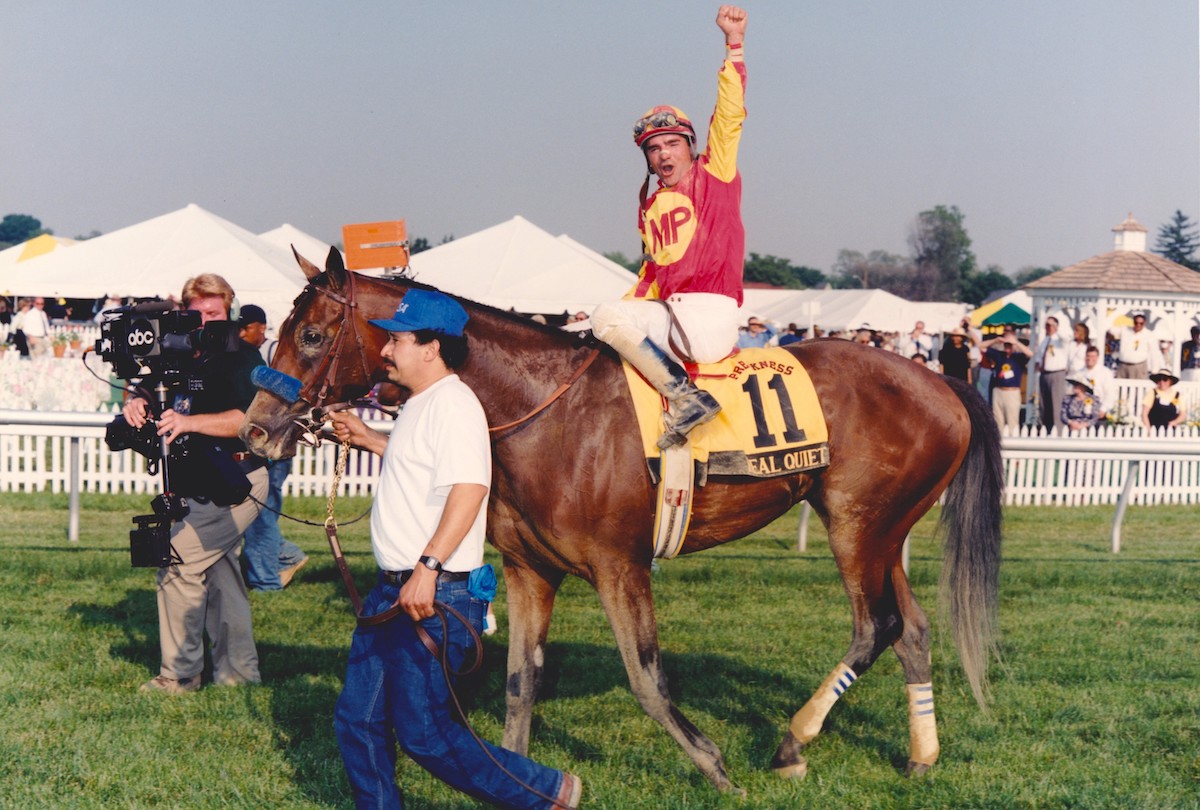 Real Quiet, by contrast, seemed to float above the fray, amazing his people daily.
Real Quiet, by contrast, seemed to float above the fray, amazing his people daily.
‘He’ll win the Belmont’
“If he stays like he is now, if I don’t mess it up between now and then, he’ll win the Belmont,” Baffert told the New York Times. “He just keeps getting stronger and stronger. I don't know where he gets his energy from.”
With a crowd of 80,162 on hand – second largest in track history – the Belmont unfolded in a fashion similar to the Derby, with Real Quiet always ahead of Victory Gallop, poised to attack the pacesetters at the rider’s command.
“You know how jockeys are always out there niggling, niggling, niggling on their horse,” said Desormeaux. “With Real Quiet, I was always asking him to wait, wait. It was like I was skiing. I spent more time on him saying, ‘Hold on, little brother.’ And because he always wanted to go, it was up to me to be the judge and tell him when it was okay to go.”
That command was given at the quarter pole. But as Real Quiet quickly reached the leading pair, they just as quickly faded away, leaving Desormeaux stranded on the lead without company or targets, and two furlongs still to run. The sight of Real Quiet on a five-length lead deep in the stretch was thrilling to just about everyone but his jockey, who could feel his colt idling beneath him.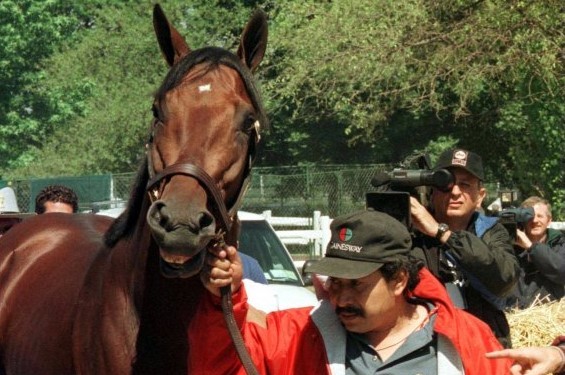
Then came Victory Gallop. After a slight course alteration to pass a tiring pacesetter, Stevens had his colt in a brisk rhythm, with Real Quiet firmly in his sights. As they reached the leader, Real Quiet shifted slightly right, although not enough to quell Victory Gallop’s momentum.
Side by side, their strides were out of sync, which meant the decision would come down to the bob of a head at the exact moment the camera was triggered. Announcer Tom Durkin pronounced the finish too close to call, and he was right. What took minutes seemed like hours before the photo was verified, and Victory Gallop’s No. 11 was posted at the top of the tote.
To lose a Triple Crown by so little – and with it the $5m bonus offered by the Visa card sponsorship – was to invite all manner of recriminations. Most of them fell upon Desormeaux, who appeared to do everything short of jumping off and pulling his colt those final few yards.
“You can hear me on the telecast yelling at him,” Desormeaux said. “Wearing blinkers like he was, he never saw the other horse coming until it was too late, and still it came down to a bob.”
Winning two additional runnings of the Derby and the Preakness, plus a Belmont in 2009 with Summer Bird, has done little for Desormeaux to erase the bitter taste of Real Quiet’s loss that day, a quarter of a century ago.
“I honestly think that if Real Quiet and I ran for the Triple Crown nine more times, we’d never lose,” Desormeaux said recently. “He got lost on the lead, and I would never let him do that again.
What had become a rousing rivalry was over. After 15 races in a span of 12 months, Real Quiet went to the sidelines for a r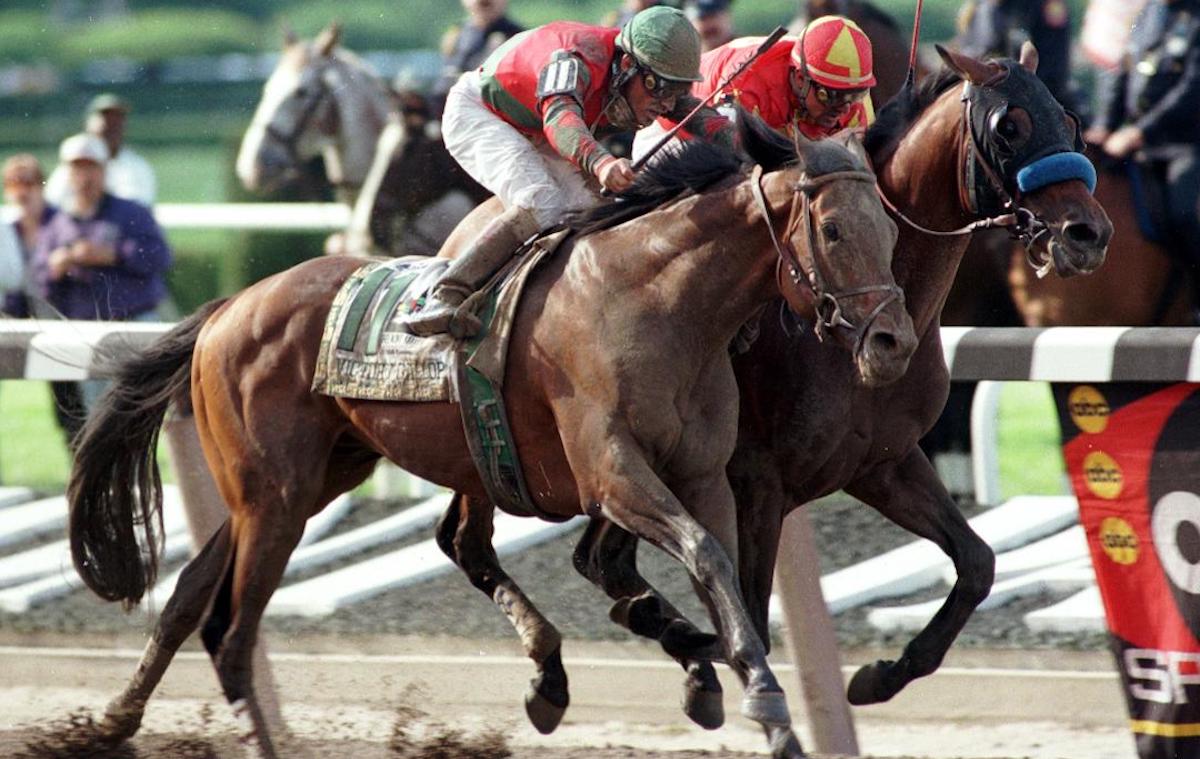 est. Victory Gallop ran on to finish second in the Haskell Invitational and second in the Travers, beaten in both by the tempestuous Coronado’s Quest.
est. Victory Gallop ran on to finish second in the Haskell Invitational and second in the Travers, beaten in both by the tempestuous Coronado’s Quest.
At year’s end, Real Quiet was acclaimed champion of the division, and no-one could fault the decision. An Eclipse Award was not a Triple Crown, but it was something.
Nine months after the Belmont Stakes, Real Quiet emerged as a four-year-old in the New Orleans Handicap at the Fair Grounds. He lost the race by a half-length to Precocity, a stakes winner at the meet.
Playing the wrong game
When Real Quiet next appeared in the Texas Mile at Lone Star, he was ridden by Gary Stevens, but he could do no better than second again, beaten a neck while playing a game for which he was not suited.
The old Real Quiet finally showed up in the Pimlico Special, just shy of a year after his triumph in the Preakness. Free House was in town, still aglow from his victory in the Santa Anita Handicap over Silver Charm.
Stevens, now firmly on board, kept Real Quiet within striking range, but when the two favorites engaged at the head of the stretch it was anybody’s race. Only in the final few strides was Real Quiet able to prevail by a neck.
The Real Quiet roadshow continued in late May at Suffolk Downs, the struggling Boston track that had been providing big paydays for appearances by marquee stars like Cigar and Skip Away. 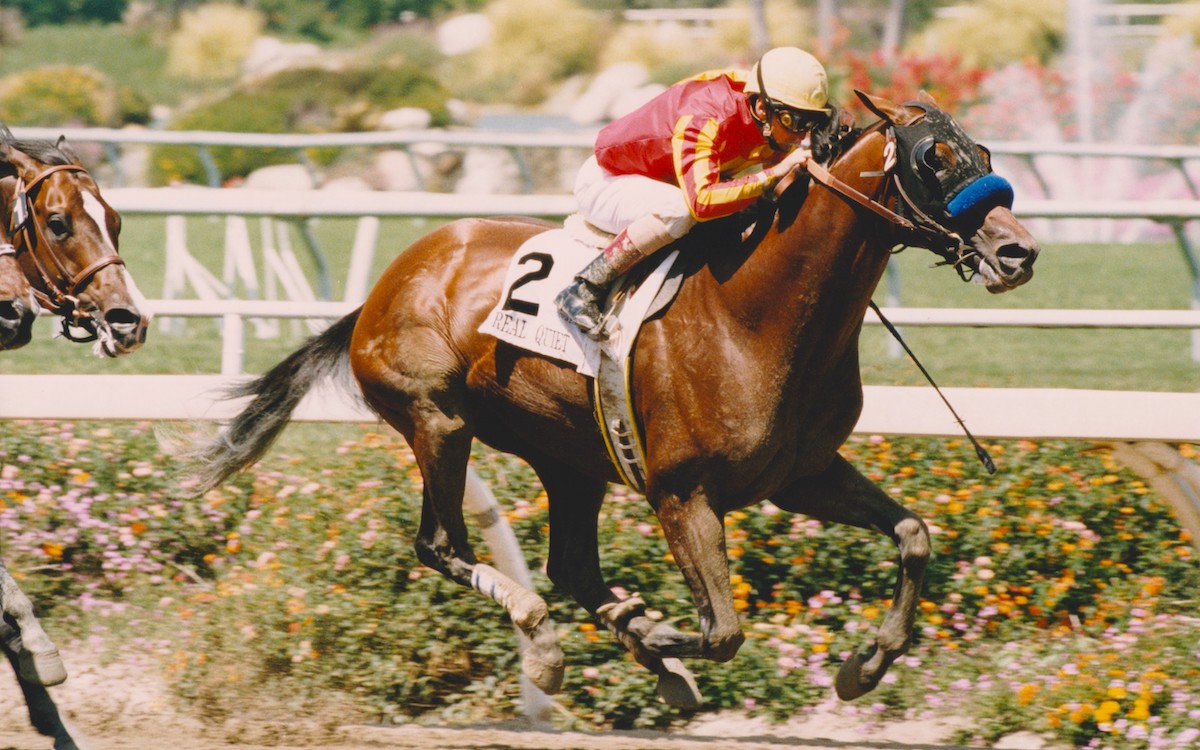
Of course, once the flag falls there are no guarantees, and Real Quiet was no match for Behrens, who was on a roll of major wins. He settled for finishing third.
More than a year and a half after announcing himself in the Hollywood Futurity, Real Quiet returned to the LA track for the 1999 Hollywood Gold Cup. Only four horses saddled up for the mile-and-a-quarter event, which guaranteed it would be a ‘riders’ race’ from start to finish. Stevens had left for England to work for Michael Stoute, so Baffert and Pegram turned to Jerry Bailey.
As Malek and Budroyale eyed each other on the pace, Bailey had Real Quiet slotted behind them on the inside. Their trip was good until the rounding into the stretch, where Bailey had to wait for Alex Solis to commit one way or another with Malek.
It was not until they passed the final furlong marker that daylight appeared on the rail. Real Quiet answered quickly for Bailey and they shot through to win by half a length.
That summer, while training for the Pacific Classic, Real Quiet fractured a splint bone. He returned to training, but then, in early 2000, he was retired to Vinery in Lexington in time to sire 86 named foals, serving dual seasons in North America and Australia.
In 2003, the stallion moved on to Taylor Made Farm, but not before signing off at Vinery in 2002 by covering the Dehere mare Candytuft. The resulting foal became Midnight Lute, Pegram’s two-time winner of the Breeders’ Cup Sprint and 2007 Eclipse Sprint Champion.
Of his other offspring, the best were Pussycat Doll, a three-time G1 winner for Pegram who sold as a broodmare for $2.3m; Wonder Lady Anne L, winner of the CCA Oaks and the Demoiselle; and Quiet Again, who settled some old family business by winning seven stakes events in New Mexico.
On your toes
Real Quiet ended his stallion career bouncing among three Pennsylvania farms and finally landing in 2008 at Penn Ridge Farms, near the state capital of Harrisburg. Patrick Morrell was Penn Ridge general manager at the time.
“You had to be on your toes around him,” said Morrell, currently the simulcast presenter and handicapper for Presque Isle Downs in northern Pennsylvania. “He didn’t like maiden mares all that much, but otherwise he was all business.”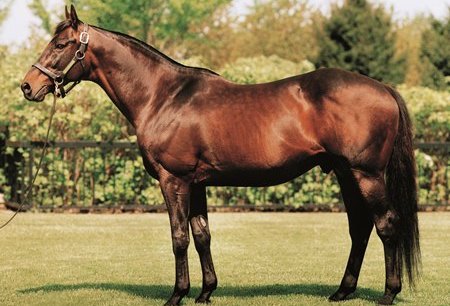
After three breeding seasons at Penn Ridge – along with a prolific 2009 tour of duty in Uruguay – Real Quiet was found down in his paddock by farm manager Chuck King on the morning of Sept. 27, 2010. Dr. Jeffrey Edelson, who did the farm’s vet work, was immediately notified. Morrell also was quickly on the scene.
“He was down, his front legs were moving, but his back legs were not,” said Morrell. “The doc gave him a couple shots of adrenalin and did everything he could. But I’ll never forget when he ran a pen down his spine to see the muscles react. About halfway down, everything stopped. That’s when we knew he was paralyzed.”
Real Quiet was euthanized in his paddock, then the body was transported to the New Bolton veterinary hospital for the necropsy required by insurance.
“None of us were there the moment it happened,” Morrell said. “I think he was just being a horse, jackassing around after getting turned out. Got up on his back legs, and the ground gave way beneath him. That’s when he flipped over, and that’s when he broke all those vertebrae.”
Penn Ridge is no longer in business. The farm is currently maintained as a goat farm, processing and selling meat and dairy products. Somewhere on the property, Real Quiet’s heart and hooves lie buried beneath a marker.
“He was always feeling good, a very happy horse,” Morrell said. “And it was a big deal to have him at the farm. People would stop by just to see him. To see the horse who was just a nose away from winning the Triple Crown.”
• Read all Jay Hovdey's features in his Favorite Racehorses series
Golden Pheasant: ‘Entering the Japan Cup walking ring was like walking into a football stadium’
View the latest TRC Global Rankings for horses / jockeys / trainers / sires


